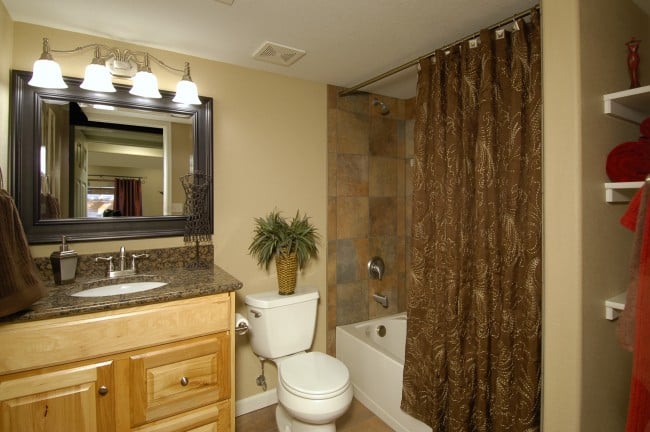
On This Page:
- Functional Considerations & Planning
- Plumbing & Electrical Considerations
- DIY or Hire a Pro?
- Conclusion
If you have a large basement, the temptation to convert your extra space into a livable area can be overwhelming. In addition to making your home more enjoyable, a finished basement will increase the overall value of your home should you decide to sell. As you consider the possibilities of your basement remodel, it’s important to also factor in the comfort of guests and family members that will be sharing your addition.
Some homeowners leave their basements as workspaces — sacrificing looks and comfort in favor of functionality. Utility aside, many homeowners still include a bathroom in their plans. A bathroom in your basement will save you extra trips upstairs, offering additional convenience and comfort.
Functional Considerations & Planning
When designing your basement bathroom, you should think about the function of your bathroom — luxury relaxation or a quick wash-up. Even with a recreation or rumpus room, a half bath is a good idea.
If you’re planning on turning your basement into an occupied living space, consider a full bath. Guests and family members will greatly appreciate the convenience of having access to a shower or tub. Before deciding on a full bath, remember that basements tend to be damp and chilly. A shower or tub may not be as comfortable as you think in an uninsulated basement.
You need to be sure that you have enough floor space for your design. While average bathroom dimensions are hard to come by, 60 square feet is a fairly common size. Small bathrooms and half baths can be 30 square feet or smaller.
Plumbing and Electrical Considerations
- Check with your local building authority for zoning ordinances and deed restrictions. The last thing you want is to have your bathroom project halted due to zoning laws.
- Place your bathroom as close to existing plumbing and electrical as possible. Ideally, you should place your bathroom directly below an existing bathroom. The close proximity will make hooking up utilities easier and much less expensive.
- Tapping into existing electrical lines is easy enough for a professional. Attach lighting and fan hook-ups to lines already present. But, remember that a ventilation fan has to vent somewhere, so ideally your bathroom should be located near an exterior wall. Your fan should be a high-powered model to ensure proper ventilation from the basement.
- Plumbing should likewise be as close to the existing system as possible. However, drainage should be paramount in any design.
- Think about normal drainage from the toilet, shower/tub and sink. All drainage lines need to have a downhill slope to let gravity take any waste water away. If you are installing plumbing at a less-than-optimal angle, you may have to install a sewage ejection pump. These pumps can cost from $150 to $3,000 depending on their horsepower.
You will have to tear up part of your basement floor to find your plumbing and electrical lines. You could do this yourself, but it’s very labor-intensive and can lead to costly mistakes. Professionals have numerous high-tech tools that can locate your lines much faster than swinging a sledge hammer. Having this knowledge beforehand will help you efficiently plan your bathroom.
DIY or Hire A Pro?
Believe it or not, installing a basement bathroom is considered a moderate DIY project. If you have experience with electricity and plumbing, you could technically install your own bathroom. Before tackling a new bathroom, check with your local building authorities. Some municipalities require modifications and additions to electrical and plumbing to be handled by a licensed professional.
Choosing to go DIY or hiring a professional also depends on your comfort level with the job and your budget. Professionally done, a bathroom in your finished basement can cost $10,000 to $15,000. DIY can cut those costs in half, but hiring a professional brings certain assurances.
In Conclusion
Adding a bathroom to your basement will increase your property value and comfort level regardless of what you’ve done with the rest of your basement. Whatever the case, a basement bathroom will only increase the enjoyment of your home.
 Hiring a Basement Contractor: Finishing, Remodeling & Waterproofing
Hiring a Basement Contractor: Finishing, Remodeling & Waterproofing  Basement Bathrooms: Weighing Cost vs. Convenience
Basement Bathrooms: Weighing Cost vs. Convenience  Laminate Floor vs. Vinyl: Which Is Better for Your Home?
Laminate Floor vs. Vinyl: Which Is Better for Your Home?  3 Bathroom Remodels You Can Afford RIGHT NOW
3 Bathroom Remodels You Can Afford RIGHT NOW  Think Home Safety with Your Basement Remodel
Think Home Safety with Your Basement Remodel 

Is it ok to install a duct mounted fan to ur basement bathroom or does the fan have to be vented to the outside